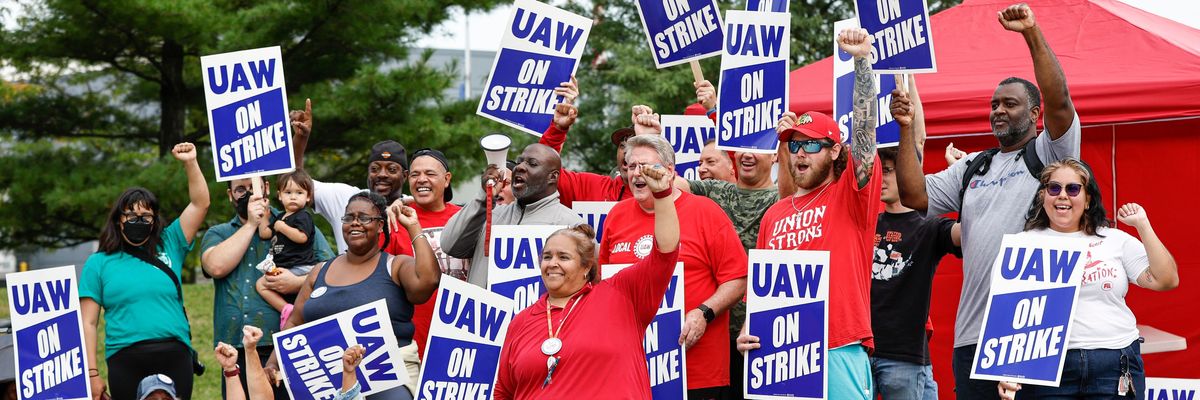While federal data released on Wednesday shows nearly half a million workers last year participated in 33 major work stoppages—the most since the turn of the century—labor experts still stressed the need for more policies protecting the right to strike.
The Bureau of Labor Statistics noted that there has been an average of 16.7 U.S. work stoppages with more than 1,000 strikers over the past two decades, meaning last year's number was almost double the norm. BLS also said that 458,900 workers joined the 2023 strikes, and nearly 87% of them work in service-providing industries, including 188,900 with jobs in education and health.
In their analysis of the data, also published Wednesday, Margaret Poydock and Jennifer Sherer of the Economic Policy Institute (EPI) pointed out that "this is an increase of over 280% from the number of workers involved in major worker stoppages in 2022, which was 120,600. Further, it is on par with the increase seen in pre-pandemic levels during 2018 and 2019."
Poydock, a senior policy analyst at the think tank, said in a statement that "a surge of workers went on strike in 2023 to fight back against record corporate profits, stratospheric CEO pay, and decades of stagnant wages. From the United Auto Workers to nurses across the country, these strikes provided critical leverage to workers to secure better wages and working conditions."
Other notable actions include the actors' and writers' strikes that together effectively shut down television and film production for months. A report released last week by researchers at Cornell University and the University of Illinois—who, unlike the BLS, also tracked smaller U.S. actions—tallied 466 strikes and four lockouts involving a total of 539,000 workers.
"It's a historic moment for the labor movement," declared Robert Reich, a former U.S. labor secretary who is now a University of California, Berkeley professor. "Workers are done letting billionaires and corporations hoard all the wealth and power."
As Poydock and Sherer, EPI's State Worker Power Initiative director, wrote in their report:
It should be no surprise that workers are taking collective action to improve their pay and working conditions—but we should be asking why it is happening now. The U.S. economy has churned out unequal income growth and stagnant wages for the last several decades. Research shows that unions and collective bargaining are key tools in combating income inequality and improving the pay, benefits, and working conditions for both union and nonunion workers. However, the continued rise in collective action is not likely to increase unionization substantially unless meaningful policy change is enacted to ensure all workers have the right to form unions, bargain collectively, and strike.
The BLS said last month that "the union membership rate—the percent of wage and salary workers who were members of
unions—was 10% in 2023, little changed from the previous year."
"In the public sector, both union membership and the union membership rate (32.5%) were little changed over the year," the bureau added. "The number of union workers employed in the private sector increased by 191,000 to 7.4 million in 2023, while the unionization rate was unchanged at 6%."
Stressing that "the increase in major strike activity in 2023 occurred despite our weak and outdated labor law failing to protect workers' right to strike," Sherer argued that "federal and state action is needed to ensure the right to strike."
At the federal level, EPI supports several proposals. As Poydock and Sherer detailed:
- The Richard L. Trumka Protecting the Right to Organize (PRO) Act includes critical reforms that would strengthen private sector workers' right to strike. The PRO Act would expand the scope for strikes by eliminating the prohibition on secondary strikes and allowing the use of intermittent strikes. It would also strengthen workers’ ability to strike by prohibiting employers from permanently replacing striking workers.
- The Striking and Locked Out Workers Healthcare Protection Act would prevent employers from cutting off health coverage of workers and family members in retaliation against striking workers.
- The Food Secure Strikers Act would allow striking workers to qualify for Supplemental Nutrition Assistance Program (SNAP) benefits.
- Congress should also pursue policies that extend a fully protected right to strike to railway, airline, public sector, agricultural, and domestic workers. None of these workers has the fundamental right to strike under current federal law.
"Right now, only a dozen states grant limited rights to strike to some public sector workers," the pair also highlighted. "States should also join New York and New Jersey in making striking workers eligible for unemployment benefits."

